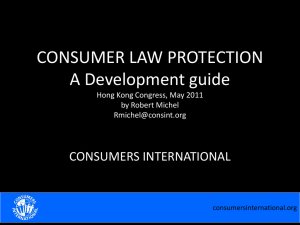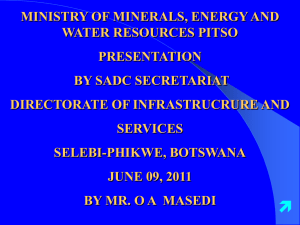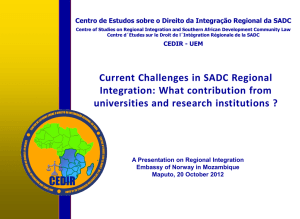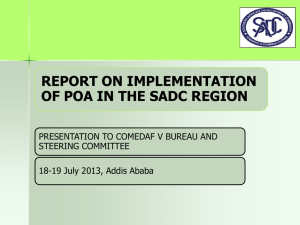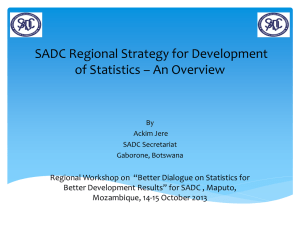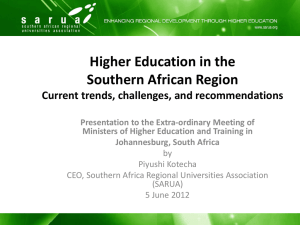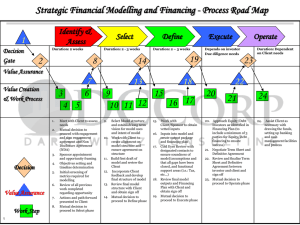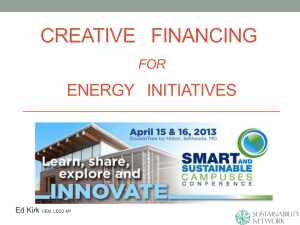FASDEV V - Coherence Financing SADC
advertisement
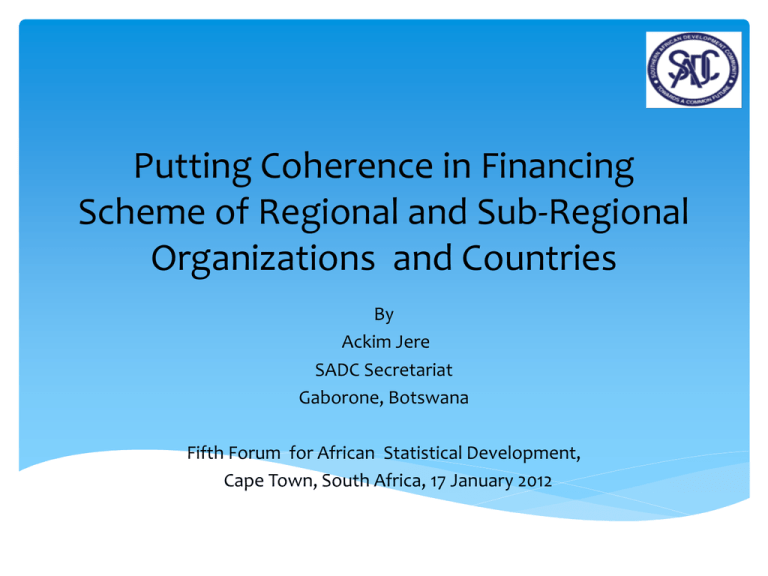
Putting Coherence in Financing Scheme of Regional and Sub-Regional Organizations and Countries By Ackim Jere SADC Secretariat Gaborone, Botswana Fifth Forum for African Statistical Development, Cape Town, South Africa, 17 January 2012 Outline of Presentation 1- Introduction 2- Major Sources of Financing 3- Institutional Framework for Mobilization of Finances for Statistics in SADC 4- Selected Key Challenges in Financing Arrangements 5- Suggestions for ensuring coherence in Financing Schemes 6- Conclusion 1- Introduction SADC - 15 Southern African States 1- Introduction (cont’d) SADC one of 8 Regional Economic Communities (RECs) recognized by African Union Commission. SADC was established at the Summit of Heads of State and Government on 17 August 1992 in Windhoek, Namibia. SADC currently composed of 15 member states, namely, Angola, Botswana, DRC, Lesotho, Madagascar, Malawi, Mauritius, Mozambique, Namibia, Syechelles, South Africa, Swaziland, Tanzania, Zambia, and Zimbabwe SADC Secretariat in Gaborone, Botswana SADC Mission: “To promote sustainable and equitable economic growth and socio-economic development through efficient productive systems, deeper cooperation and integration, good governance, and durable peace and security, so that the region emerges as a competitive and effective player in international relations and the world economy 2- Major Sources of Financing Generally Financing for statistical projects or programmes is provided by strategic stakeholders and Cooperating partners Level Financing Source Level Financing Source Country Level National Governments Cooperating Partners Sub-Regional Level Member States Cooperating Partners Regional Level Member States Cooperating Partners Other sources 2- Major Sources of Financing (Cont’d) Selected SADC Statistics Projects – Financing Sources (2001 – 2010) Project Name Objective Financing Source SADC Statistics Training To enhance capacity for production and utilization of official statistics in SADC MS EU and SADC MS Poverty Reduction Strategy To increase statistics capacity in MS for analysis of poverty statistics World Bank Harmonisation of Foreign Trade Statistics To standardise concepts and definitions , processes, nomenclature and methodology for production of IMTS EU, French Government and SADC MS Harmonization of Consumer Price Statistics To produce comparable CPIs among MS to facilitate SADC HCPI. EU and AfDB Development Account Project To enhance MS capacity to generate indicators for MDGs monitoring UNSD iA SADC Census Millennium To enhance MS capacity to analyze Census data Rock feller Foundation 3- Institutional Framework for Mobilization of Finances for big Statistics projects in SADC SADC Statistics Committee draws out project proposals for SADC Council of Ministers consideration and approval as appropriate After Council approval, Secretariat initiates process seeking for finances from funding agencies Process can be protracted depending on prevailing circumstances 4- Some Key Challenges relating to Financing Arrangements Existing financial regulations for some implement; ICP funded projects sometimes cumbersome to Effective coordination among ICPs leading to duplication in efforts or confrontation at national and sub-regional levels; Lack of proper sustainable mechanisms following end of financial commitments for projects funded by ICP; Inadequate capacity at sub-regional level to effectively deal with financial matters for project implementation; SROs and Member States programmes sometimes chasing different priorities amidst limited financial resources; and Sometimes the lack of elaborate and clear communication channels between member states, RECs and financiers leading to delays in accessing and utilization of funds. 5- Suggestions for ensuring coherence in financing schemes Mainstreaming of key elements of regional/sub-regional programmes into national programmes within the NSDS frameworks of Member States in an integrated manner to rationalize use of limited financial resources especially ICP funds; Need for comprehensive alignment of strategic plans at both national and sub-regional/regional levels. This to provide reference frameworks and basis for financing projects and programmes in a coherent fashion. Establishment and building of robust and sustainable administrative and financial capacity and systems in both Member States and regional/sub regional organizations; Adapting ICPs financial regulations to circumstances of recipients organizations to facilitate increased uptake and utilization of financial resources. EU Contribution agreement approach good example. 5- Suggestions for ensuring coherence in financing schemes ( cont’d) Conduct of regular training and building or enhancement of capacity on Administrative and Financial regulations for ICPs financed projects for staff at national and SRO levels. Enhancement of Advocacy strategy for statistics especially targeted at decision and policy makers in Member States and SROs for sustained financing; SROs/RECs and pan African institutions need to be sharing experiences and best practice more frequently in financing of projects and related matters within the context of the aims and objectives of the Africa’s continental integration agenda. 6- Conclusion Among other things, coherent financing schemes can facilitate access to more financial resources for sustainable project implementation. Thank you for your attention
